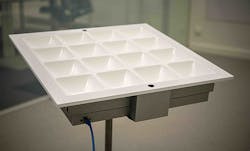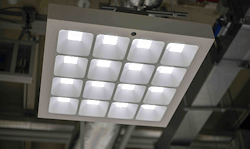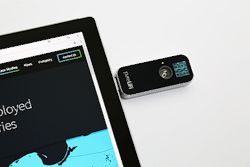With any emerging technology, the truth often lies somewhere between the hype and the naysayers. That certainly describes Li-Fi, the long-percolating LED concoction in which light waves from luminaires, rather than radio waves from Wi-Fi modems, might one day routinely deliver Internet service the way Wi-Fi does today.
Li-Fi portends a number of advantages. One of them is that it opens up a vast amount of spectrum to wireless Internet service, which will help alleviate a bandwidth crunch that already today can cause signals to clash, and is a situation which looks set to worsen.
And Li-Fi appears to be more secure for the simple reason that it requires line of sight with the light source, so a hacker cannot pirate it from outside a building.
The list goes on. Li-Fi is not susceptible to electromagnetic interference, so it eliminates the clashes that can happen with phones, with multiple Wi-Fi systems, or with whirling machines and robots on factory floors. As it does not emit radio frequencies, it is an alternative for critics who say that Wi-Fi wavelengths are dangerous to humans — such as in France, which has banned Wi-Fi in some schools.
However, one common hyperbole for Li-Fi, promoted by some over-excited enthusiasts, has been that it’s faster than Wi-Fi. While on paper the sheer transfer rates have indeed looked faster, candid Li-Fi developers have often conceded that the two technologies offer roughly the same speed, once all practical working conditions kick in.
But that seems to be changing, judging by the accounts of some trial users such as Vincent Tey, who is deploying Li-Fi at Singapore’s Republic Polytechnic, where he is the assistant chairman of the electrical and electronic engineering department (Fig. 1).
“It’s 20 to 30 times faster,” he said, comparing Li-Fi to his former Wi-Fi system.
Cranking it up
Indeed, Li-Fi is now beginning to live up to claims that it is faster than Wi-Fi, making honest people out of the exaggerators.
Certainly, the raw, stated rates are quickening. As LEDs Magazine reported earlier this year, one Li-Fi vendor, Scotland’s pureLiFi, has cranked up rates to a blistering 1 Gbit/sec, roughly a 20× boost over its earlier maximum of around 43 Mbit/sec.
PureLiFi is not Tey’s supplier. Rather, Tey has turned to Signify, the world’s largest lighting company, which is making a strong push into Li-Fi, having acquired at least two Li-Fi companies since late 2016 — Luciom and, recently, FireFly.
Signify’s stated speed is nowhere near a gigabit. It’s 30 Mbit/sec. That’s a speed that, on paper, is comparable to what many broadband service providers advertise today.
But that has been more than enough to make the pronounced difference to Tey, his crew, and students at 17-year-old Republic Polytechnic, a government-funded, university-level school where 13,600 students focus on practical course work in engineering, applied science, hospitality, business management, sports, health, leisure, and other fields.
“With Wi-Fi, when you download a video, the video tends to stop for a while,” said Tey. “Sometimes you receive it well, and sometimes you don’t. With Li-Fi, there are no delays at all. The transfer is much faster. It’s 20 to 30 times faster, sometimes 100 times faster.”
FIG. 2. This Signify Li-Fi luminaire is similar to the one that Republic Polytechnic is using. (Photo credits: Signify.)
Tey’s Li-Fi at Republic Polytechnic’s smart devices lab is not a big implementation. It’s small. Last October, the school replaced the standard LED lighting in the lab with a single Li-Fi-equipped LED panel luminaire from Signify measuring roughly 2.5×1.5 ft (similar to the luminaire shown in Fig. 2). The new luminaire includes electronics that modulate LED light waves in a manner imperceptible to human eyes but that changes fast enough to embed the zeroes and ones of digital transmission. The LED luminaire sits directly above an area used by 4–6 students at a time. Students receive the signals on laptops outfitted with a USB dongle. The same dongle transmits back to the lights using infrared pulses.
Ethernet too
In another bit of modernization, the lab also ran Internet-connected Ethernet cables straight to the luminaire, using the wire as a conduit of both data and electricity, a technology known as Power over Ethernet.
In fact, Tey credits the direct Ethernet connection for helping to quicken the pace of Internet transmission (another wired technology, powerline communications, could also do the job). In the old Wi-Fi setup, wireless signals would travel further, encountering obstacles and attenuation — which do not exist in the direct, close-up line of sight connection with the lights.
Tey and the lab have been kicking the tires on the system since October. So far, so good. Not only is it faster than Wi-Fi but Tey described the reception as problem free, “because LED is a very durable light source.” Whereas Wi-Fi speeds can suffer from interference from other radio waves, from structures like walls blocking signals, and from users sharing frequencies, Li-Fi has none of that. “As long as the light hits the computer, the same amount of data will be constantly streamed to all the users,” Tey said.
The flip side of the line of sight is that Li-Fi’s range tends to not extend as far as Wi-Fi’s. But in the back-and-forth comparison of the two technologies, that also plays right into Li-Fi’s security advantages.
“Yes, you have to be under the light, which means the range is not is wide as Wi-Fi,” said Tey. “But at the same time, it makes the system more secure. No one outside the room can access it. As long as you’re outside the light beam, you cannot receive it.”
The lab will start to put the Li-Fi installation through its full paces in April, when one team of students will try to figure out how to make it even faster, and another team will analyze its security aspects.
“We want to see if we can improve it, to see if we can push it further,” said Tey.
It’s a fine academic pursuit in its own right, and one that Tey is tasking to his final-year students as their project.
Have Li-Fi, will research
There’s added motivation for why the teams will try to advance the technology: They are essentially working as a research group for Signify, which has provided the technology free of charge to Republic Polytechnic. It’s all part of a memorandum of understanding signed by the two entities last Oct. 31, calling for them to collaborate on Li-Fi development and presenting opportunities for students to visit Signify’s Singapore facilities and to possibly work as interns there.
The teams are also eyeing the possibility of developing the technology for wider use across the Republic Polytechnic campus. In the wider use case, though, they are not for the moment examining full two-way Internet service.
Rather, they are exploring a one-way version of the technology, known as visible light communication (VLC) in which lights would communicate with phones and other gadgets to provide navigation and location assistance. (VLC in its two-way form typically goes by the name Li-Fi, and in its one-way form by VLC).
“It might help find library books, or it might help guide students or visitors around the campus,” Tey said, imagining out loud just some of the possibilities for VLC.
VLC is only one form of lighting-based location technology, with another being Bluetooth. As LEDs reported in the February issue, lighting-based positioning systems have been slow to take off, characterized by a growing number of pilots and trials but not yet winning widespread installation.
FIG. 3. The pureLiFi dongle is as slick as a Li-Fi dongle can be. But it’s still a dongle, representative of the state of Li-Fi across the industry. Mass commercialization probably won’t happen until gadget makers embed the components, not expected until at least 2021. PureLiFi recently rebuilt an HP laptop (not pictured), embedding Li-Fi chips and displaying it at the recent Mobile World Congress in Barcelona. (Photo credit: pureLiFi.)
Li-Fi, which traces its commercial roots back to at least 2012 when Edinburgh-based pureLiFi was founded, has arguably been even slower to catch on. And here’s where the naysayers are still correct: One thing holding back Li-Fi is that laptops, phones, and gadgets have yet to embed chips in their devices to support the technology. Thus, users like the students at Republic Polytechnic have to attach dongles, a step that is widely regarded as costly and a nuisance, especially as Wi-Fi requires no such inconvenience (Fig. 3).
While vendors such as pureLiFi have miniaturized the electronics such that they can reside inside gadgets, gadget makers have thus far resisted. That might change by 2021, the year that international standards body IEEE is expected to finally ratify a Li-Fi standard. As with any standards effort, the protracted deliberations have reportedly been characterized by industry in-fighting.
Test pilots
Thus, the end user examples tend to be small and test-oriented, like at Republic Polytechnic. When Signify recently revealed that it now has about 30 such pilots underway, none of the examples pointed to anything of a large scale (Fig. 4). It identified only four of the locations by name, one being Republic. Signify described a deployment at a Paris area office of telecoms company Orange as a “pilot” and a “test.” It characterized an installation in the lobby of IT firm Atea in Stavanger, Norway as a “pilot” and a “demonstration.” Likewise, in Bangalore, India, managed office provider Incubex has established a single Li-Fi meeting room to help Incubex companies “explore the technology,” Signify said.
FIG. 4. In this mockup photo — note the absence of dongles — office workers stay busy in a reception area by accessing the Internet through the lights using Li-Fi technology. (Photo credit: Signify.)
But 30 examples is indeed progress in the slowly evolving endeavor of Li-Fi. “Our initial pilots illustrate the massive potential of this technology,” said Michel Germe, Signify’s head of Li-Fi. “We’ve received hundreds of enquiries from potential customers from all corners of the world, some of which have led to applications inspired by them and jointly created with them, such as communication between robots in manufacturing facilities. As well as the 30-plus pilot projects, we’ve installed Li-Fi in 26 of our buildings across the world.”
Other vendors are also gradually building up a portfolio of small case studies. PureLiFi’s trial sites include a small installation in a room at the London area headquarters of Telefonica-owned UK mobile network operator O2; a testbed with British engineering firm Babcock at a dockyard in Plymouth, England; a training center with British telecoms training firm Ubi-Tech; and others. Paris-based Oledcomm counts Perpignan Hospital among its early sites, where it has outfitted the corridors of the pediatrics ward with Li-Fi.
Proponents of Li-Fi say it will help offload the burden on Wi-Fi, which could rapidly run out of space as billions of devices connect to the burgeoning Internet of Things (IoT), weighing down Wi-Fi’s limited radio spectrum. Harald Haas, co-founder of pureLiFi, has noted that Li-Fi potentially adds 300 THz of spectrum compared to Wi-Fi’s 300 GHz, a difference of 1000×. Thus, some people consider it an integral part of 5G, the next step up in general wireless technology, expected to arrive this year or next.
No wonder, then, that more lighting companies are starting to get behind Li-Fi technology. For example, the new CEO of Zumtobel gave it a ringing endorsement days before his company and pureLiFi jointly displayed the technology at the Mobile World Congress in Barcelona, and revealed that they are collaborating on a small trial at Zumtobel headquarters in Dornbirn, Austria.
“We believe that in an increasingly interconnected digital world, Li-Fi will play a decisive role in moving our industry into the era of digital light,” noted Zumtobel boss Alfred Felder, stopping short of committing to commercializing the technology.
And now that Li-Fi appears to be ready to surpass Wi-Fi speed, perhaps the move to commercialize, standardize, and lower its cost will also quicken. The truth of that will turn out to be somewhere between what the enthusiasts claim and the skeptics doubt.
MARK HALPER is a contributing editor for LEDs Magazine, and an energy, technology, and business journalist ([email protected]).









